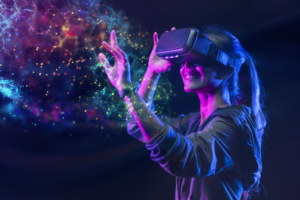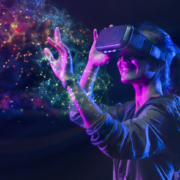Leveraging VR, AR & AI for CTE student success
The adoption of virtual reality (VR), augmented reality (AR) and artificial intelligence (AI) in education is transforming how we learn. These technologies help us to explore topics in a way that has never been possible before. AR allows us to project digital content into the real world and, used together with VR, students experience immersive simulations. AI can be used on its own or supporting VR and AR to provide immediate feedback and individualize learning.
Take a chance on these technologies; you may see increased engagement as students begin to interact with what they’re learning on a more personal level. VR, AR and AI can also help students who may struggle with comprehension. Perhaps most significant, technology can empower students by giving them more agency over the learning process.
VR, AR & AI: What are they?
Virtual reality, augmented reality, and artificial intelligence technologies emerged some time ago now. The terms are sometimes used interchangeably. But while there is a convergence between the three, they each have distinct characteristics.
VR uses a computer to simulate a 3D image or environment, accessed using special equipment like a headset. Users can explore and interact with an artificial environment that seems real! The user may even experience the feeling of being in another place. Virtual reality experiences can also include social interactions with other individuals. For example, I can enter a virtual workplace using my VR headset and conduct a meeting with people around the world just as if we were in person. I can write on a whiteboard in that virtual space, retrieve files to put on the screen and more.
Augmented reality blends the physical and digital worlds to produce new environments and visualizations where physical things coexist with virtual elements. It overlays information and digital content onto the physical world. AR provides a live — direct or indirect — view of a physical, real-world environment where elements are augmented by sound, video, graphics or GPS data.
Finally, artificial intelligence (AI) can be defined as the theory and development of computer systems able to perform tasks that require intelligence when performed by humans. AI includes machine learning, natural language processing, and speech recognition. Artificial intelligence is being used to help students better understand textbooks through applications such as quizzes based on one’s reading speed.
Technology changes the way we learn and work.
VR, AR, and AI are changing the way we learn in classrooms and in the workplace. Now, teachers can create immersive experiences that will help students build stronger understanding of technical and employability skill concepts. In Madison, Alabama, KTech Beta Academy partnered with Bob Jones High School Engineering Academy to prepare students for the workplace using VR that simulates on-the-job experiences. As a part of the program, students will have an opportunity to interview for an internship with Transfer VR. This demonstrates new intersections of technology, education and the workforce. VR, AR and AI can support CTE students as they develop technical and employability skills.
Students benefit from opportunities to visit workplaces and other sites around the world through virtual reality field trips. They gain new perspectives, engage in hands-on learning activities, solve complex problems through collaboration, and learn to communicate effectively. Further, VR and AR can provide training programs that allow students to experiment with expensive and sometimes dangerous tools and materials. For example, fire science programs and law and public safety classes can use this tech to conduct skill development without putting students at risk during the training process.
What does this mean for the future of education?
What does this mean for the future of education? Consider how we can integrate these new technologies into career and technical education classrooms to improve student engagement, training and comprehension. VR, AR and AI make learning immersive, allowing us — all of us — to explore topics in greater detail.
“When building the infrastructure to support our students, do not forget the infinite space that the meta-universe will impact,” said Robert Marraccino. “Create new, open spaces so technology can be brought in and repurpose existing spaces for active learning. The days of permanent hardwood lab benches and large power supplies that housed vacuum tubes are gone. Follow the career pathway into the meta-universe!”
Dell Technologies forecasted that the pace of change will continue so exponentially that adoption of AR and VR will become necessary. Knowledge of a career path will not suffice; the ability to gain new information in the moment will be more valuable. Consider the impact that statement may have on education delivery. As a result, the ability to access and obtain new information will be more beneficial than rote memorization of facts and figures.
There are many benefits of using VR, AR or AI in a classroom setting.
The most notable benefit, I mentioned earlier. Increase student engagement! VR and AR facilitate the creation of immersive learning experiences that allow students to explore topics in greater detail. Additionally, VR and AR may improve communication by providing a more interactive learning environment. Finally, AI can automate assessment tasks and provide personalized feedback to students, giving time back to educators.
What makes these technologies so unique is that they provide students with the opportunity to interact with ideas in ways that haven’t been possible before. Perhaps one of the most significant benefits is that technology can empower students by giving them more agency over the learning process. With these technologies, students can create avatars that look like them and interact with concepts in unique ways based on their interests. This increased agency motivates students and makes learning more fun.
This technology may also incentivize students — to have fun! And learn! — by implementing a rewards-based system. Yes, students complete quizzes and assessments on the platform(s). And they may also gain experience points or level up to unlock new features for their avatars.

Conclusion
VR, AR and AI offer much more than gaming. They’re already transforming the classroom and the workplace. And, while it’s true that technology cannot replace the nuances of the real-world, simulations offer significant benefits for career and technical education students who prepare to enter an evolving workforce.
Rachael Mann is a tech and education speaker and writer. Her work examines how emerging technologies like AI, VR, and AR are shaping the future of learning and what it means for schools. Follow her on Twitter.



